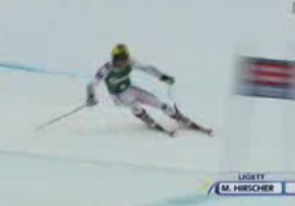Setting up the turn with lower body; tipping with no or little pressure on the skis.

Inside leg flexing and added tipping angles move CG closer to the snow.

Pressure and hold increase at critical part of the arc due to the ski reaction to tipping and flexing leg movements

Balances and pressure are in control and a flexing release is used.

This is brilliant skiing, no extra movements, everything in perfect balance. in the last frame upper body perfectly facing stance boot, ready for release.
Entering the arc the outside ski loses grip and skids tail. Upper body rotation follows as grip is lost.

Angles increase as counter balance increases. Knee angulation excessive, pressure to the ski late.

The outside ski has not reacted well, because it isn't developing strong enough hold and pressure; more forward leverage and a steering femur are necessary to keep it directed, this keeps the ski hooking uphill.
The knee has a much bigger angle to the snow than his ski boot and ski. The ski boot and ski are not reacting to his method of tipping. This doesn't happen with the Austrians I'm showing. It's a real problem and it's mostly mechanical, there are no movements that can fix this.

A leg extension is the only alternative, in this case to exit the turn, because the knee is so far committed to create grip and hold it isn't ready to release. The knee can't release, if the skier still needs hold and edge grip. This results in loss of speed, direction and rebound energy.

Although the difference between a winning Slalom skier and a 10th place slalom skier are often considered to be minimal and the gap between the two, seems attainable; many WC racers never bridge the gap. The comparison between these two skiers tells the story. Take particular notice of the ski angles to the slope in the last photos of the comparison. Not edge angles. Also take note of the times framed in the photos.


















































